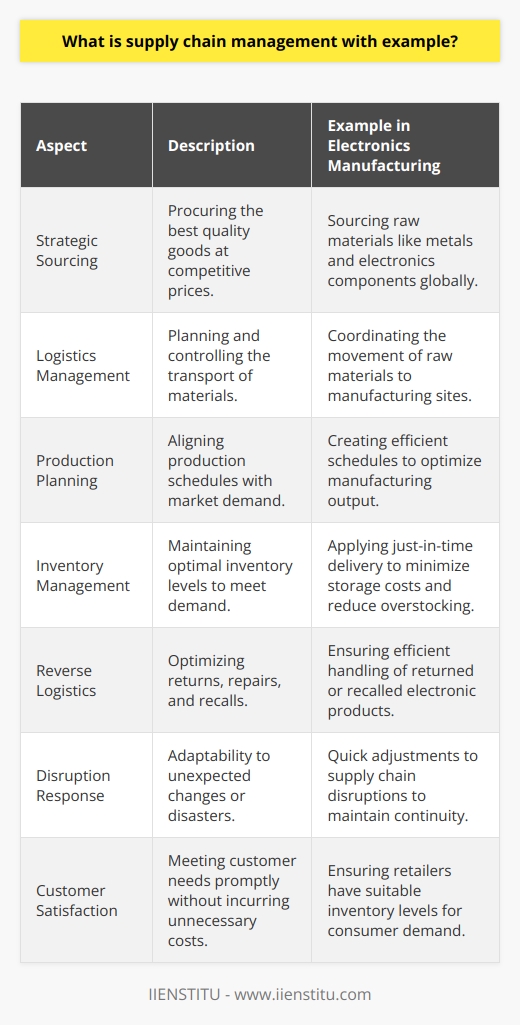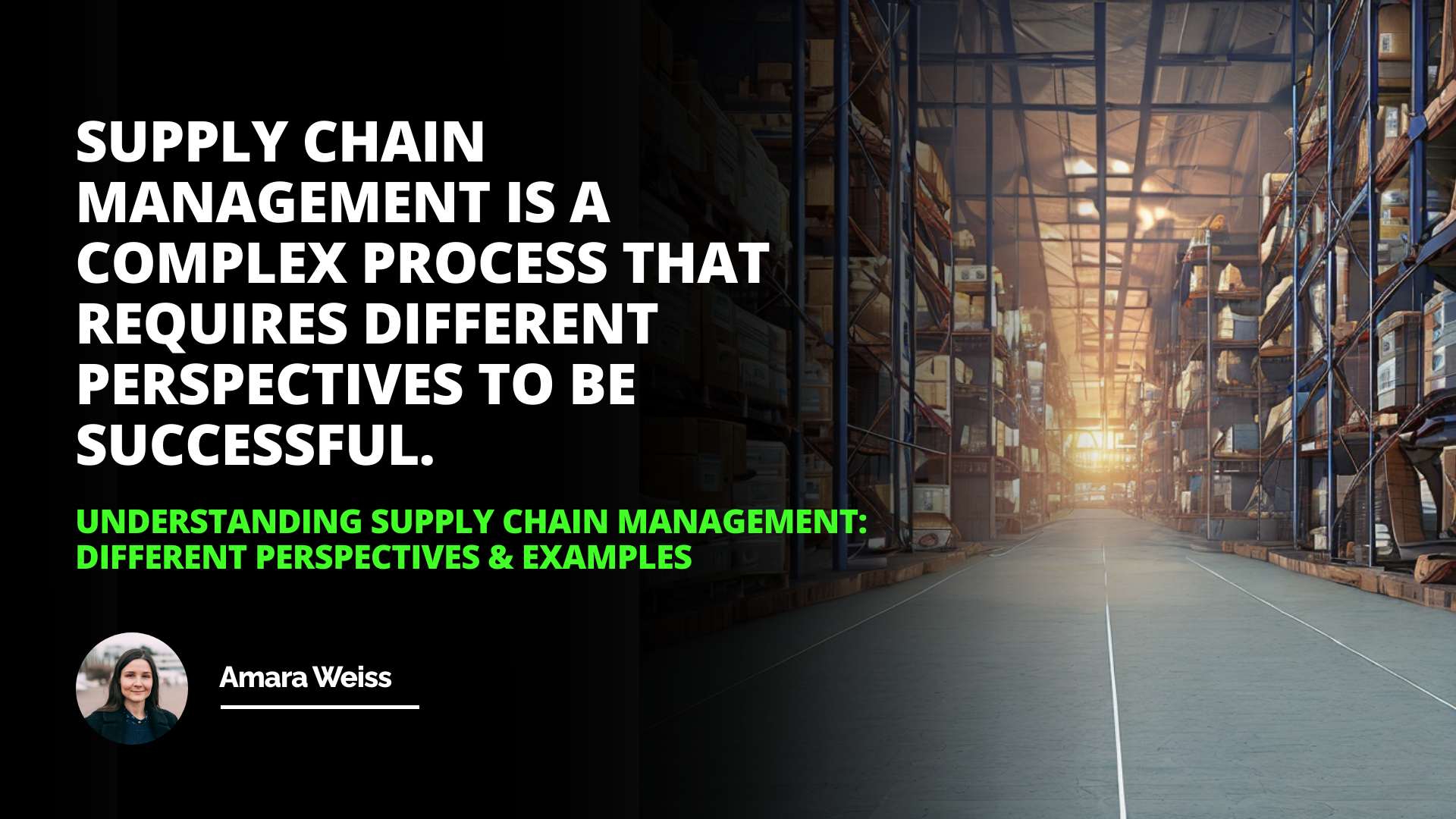
This article discusses the different perspectives on supply chain management, including the traditional supply chain view, the demand-driven view, the customer-centric view, and the sustainability view.
Each of these views provides a unique perspective on the supply chain and can help supply chain managers identify areas for improvement and opportunities to increase customer satisfaction.
Introduction
Different Perspectives on Supply Chain Management
Examples of Different Perspectives
Benefits of Analyzing Supply Chains from Different Perspectives
Conclusion
Introduction: Supply chain management is a complex undertaking that requires a holistic view of the entire process. It involves coordinating multiple elements, including suppliers, manufacturers, distributors, and customers. This complexity can be difficult to manage, but it can be made easier when supply chain managers consider different perspectives. By looking at the supply chain from different angles, managers can gain a better understanding of how their supply chain is actually working and can identify areas where improvements can be made.
Different Perspectives on Supply Chain Management
There are several different ways to analyze a supply chain. These perspectives include the traditional supply chain view, the demand-driven view, the customer-centric view, and the sustainability view. Each of these views provides a unique perspective on the supply chain and can help supply chain managers identify opportunities for improvement.
The traditional supply chain view looks at the supply chain from a linear perspective. This view focuses on the various stages of the supply chain, from the supplier to the customer. It considers the costs, resources, and processes associated with each stage of the supply chain. This view is useful for understanding the overall cost of the supply chain and for identifying areas where improvements can be made.
The demand-driven view looks at the supply chain from the customer demand perspective. This view takes into account the customer’s needs and expectations and looks for ways to meet those needs in a cost-effective manner. This view is useful for identifying opportunities to increase customer satisfaction and improve the supply chain's efficiency.
The customer-centric view looks at the supply chain from the customer's perspective. This view takes into account the customer’s experience and looks for ways to improve the customer’s experience. This view is useful for identifying opportunities to increase customer loyalty and for improving the customer’s overall experience with the supply chain.
Maximizing Inventory Costs: Tips for Supply Chain Management
Connecting Supply Chain Communities: How Culture Impacts Supply Chain Management
The sustainability view looks at the supply chain from environmental and social responsibility perspectives. This view takes into account the impact of the supply chain on the environment and on society. This view is useful for identifying opportunities to reduce the environmental impact of the supply chain and for improving the social impact of the supply chain.
Examples of Different Perspectives
To illustrate how different perspectives can be used to analyze a supply chain, consider the following example. A company is looking to reduce the cost of its supply chain. From a traditional supply chain perspective, the company could look at the cost of each stage of the supply chain and identify areas where costs could be reduced.
From a demand-driven perspective, the company could look at customer demand and identify ways to meet customer needs cost-effectively. From a customer-centric perspective, the company could look at the customer experience and identify ways to improve the customer’s experience.
Finally, from a sustainability perspective, the company could look at the environmental and social impact of the supply chain and identify ways to reduce the environmental impact and improve the social impact.
Benefits of Analyzing Supply Chains from Different Perspectives
Analyzing a supply chain from different perspectives can provide several benefits. First, it can help supply chain managers better understand the supply chain and identify opportunities for improvement. Second, it can help supply chain managers develop strategies tailored to their customers' needs. Finally, it can help supply chain managers develop strategies that are more sustainable and that have a positive impact on the environment and society.
Conclusion: Analyzing a supply chain from different perspectives can provide several benefits. By looking at the supply chain from different angles, supply chain managers can better understand how their supply chain works and identify areas where improvements can be made.
This can help them develop strategies that are tailored to the needs of their customers and that are more sustainable. By taking multiple perspectives into account, supply chain managers can ensure that their supply chains are functioning optimally and taking into account the needs of their customers, the environment, and society.
Supply Chain Management is a complex process that requires different perspectives to be successful.
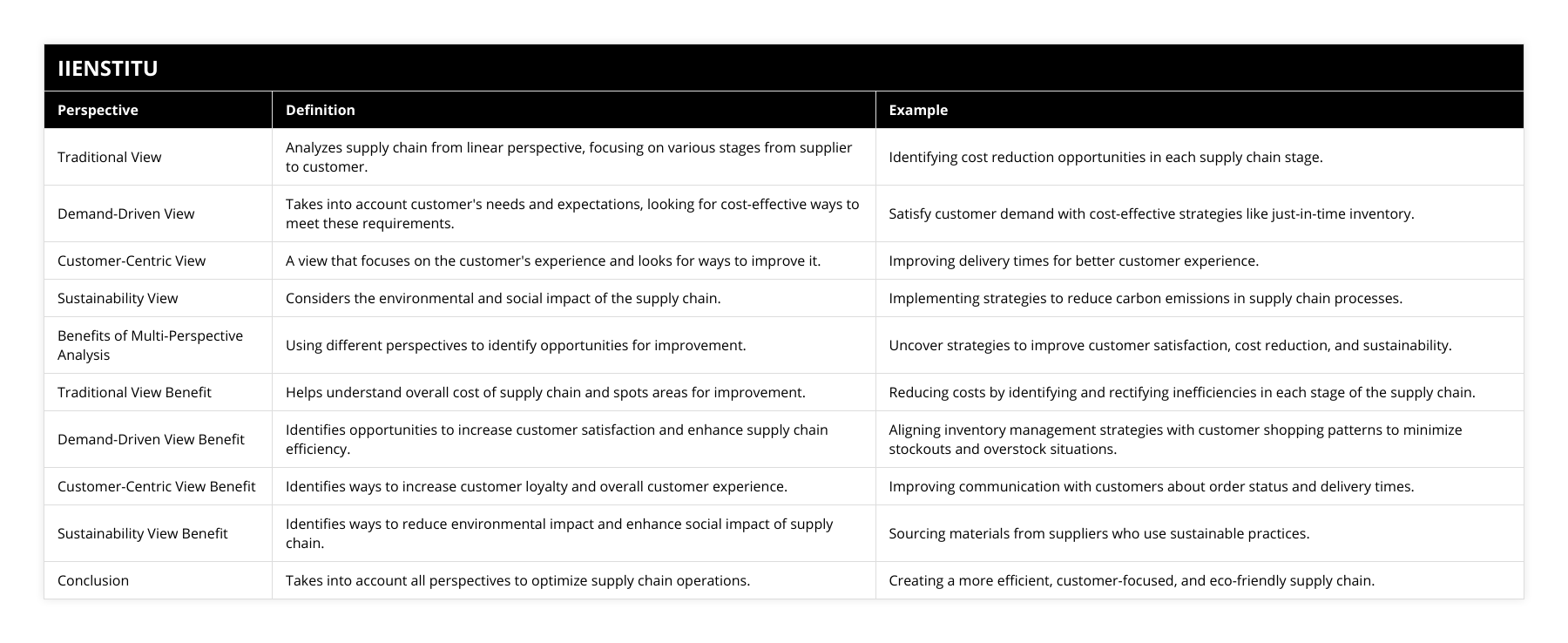
Frequently Asked Questions
What are the different perspectives on supply chain management?
The traditional supply chain view focuses on the efficient management of the supply chain from the point of view of the supplier, emphasizing the importance of cost minimization and operational efficiency. The demand-driven view is a customer-centric approach that emphasizes the importance of responding to customer demand in a timely and efficient manner. The customer-centric view emphasizes the importance of customer experience, and the sustainability view emphasizes the importance of managing the supply chain in an environmentally and socially responsible way. Each of these views offers unique insights into supply chain management, and can help managers identify areas for improvement and opportunities to increase customer satisfaction.
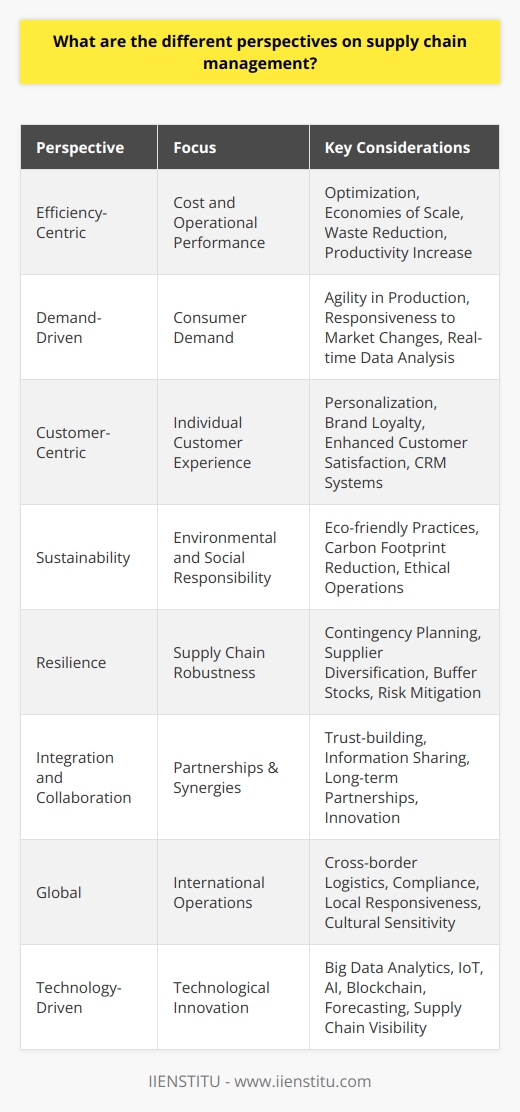
What are the benefits of analyzing supply chains from different perspectives?
The benefits of analyzing supply chains from different perspectives are manifold. Taking a traditional supply chain view can help uncover inefficiencies and identify areas of improvement, while the demand-driven view can help optimize costs and increase profits. The customer-centric view can help identify customer preferences and tailor supply chain strategies to meet customer needs, while the sustainability view can help ensure that the supply chain is compliant with environmental regulations and reduce the organization’s carbon footprint. By examining supply chains from different perspectives, supply chain managers can ensure that their strategies are optimized for maximum efficiency and customer satisfaction.
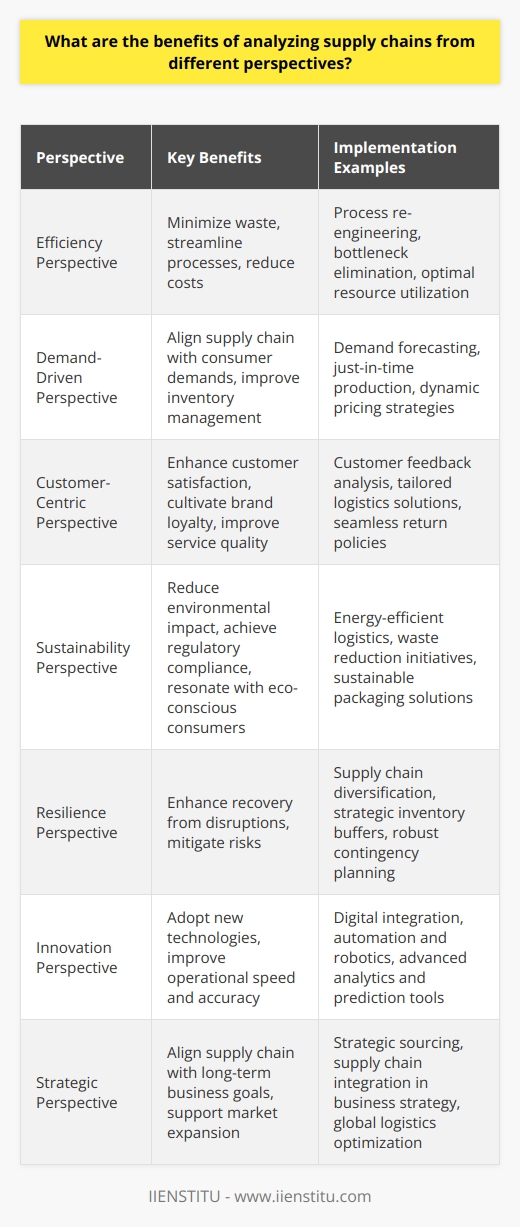
What are some examples of different perspectives on supply chain management?
Traditional Supply Chain View: This view focuses on the physical flow of goods and services from the supplier to the customer. It emphasizes the need for efficient, cost-effective processes and emphasizes cost cutting to maximize profits.
Demand-Driven View: This view focuses on customer needs and understanding the market. It emphasizes responding to customer demand quickly and efficiently, and understanding the customer’s purchase journey.
Customer-Centric View: This view focuses on the customer experience, emphasizing customer service, customer satisfaction, and customer loyalty. It emphasizes the need to create a seamless customer journey and provide a positive customer experience.
Sustainability View: This view focuses on the environmental and social impacts of the supply chain. It emphasizes the need for sustainable practices, such as reducing emissions and waste, and promoting ethical labor practices.
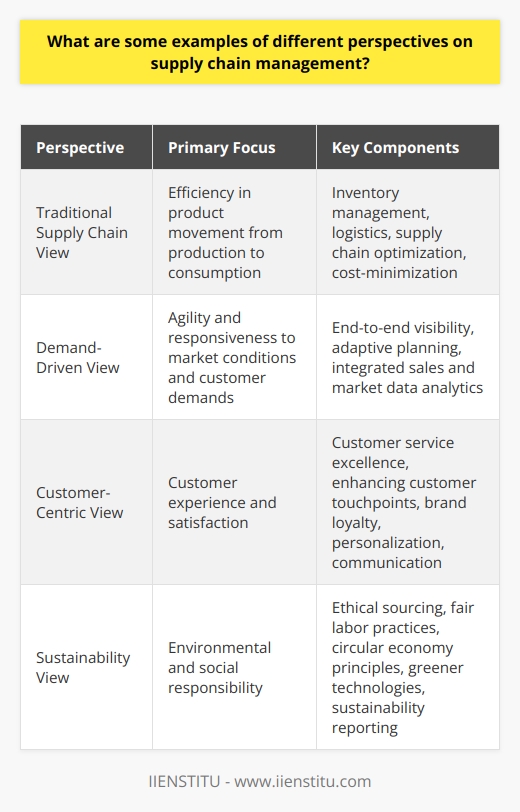
What are the key factors to consider when examining supply chain management from different perspectives?
Supply Chain Perspectives
When analyzing supply chain management, it is essential to consider several key factors that influence its effectiveness and efficiency from various perspectives. These factors include strategic fit, technology adoption, risk management, and sustainability.
Strategic Fit
Strategic fit refers to the alignment between the supply chain strategy and the overall competitive strategy of the company. This is critical when examining supply chain management, as a well-aligned supply chain can offer a significant competitive advantage. Firms must ensure that their supply chain design supports their product or service positioning in the market while also addressing the specific needs and preferences of their target audience.
Technology Adoption
In today's increasingly digital landscape, the use of technology within the supply chain is critical for success. This factor entails the integration and optimization of various technological tools and systems such as enterprise resource planning (ERP), transportation management systems (TMS), and warehouse management systems (WMS). These technologies can improve the overall efficiency of the supply chain, increasing its agility and responsiveness to fluctuating market demands.
Risk Management
Supply chain risk management focuses on the identification and mitigation of potential disruptions or vulnerabilities within the supply chain. This can include supplier performance issues, natural disasters, geopolitical instability, and even economic downturns. By assessing and addressing such risks, companies can enhance the resilience of their supply chain, reducing the likelihood of costly disruptions and ensuring the steady flow of goods and services.
Sustainability
In response to rising environmental concerns and increasing consumer demands for responsibly sourced products, sustainability has become a key factor to consider when analyzing supply chain management. Companies must address the environmental and social impacts of their supply chain activities, incorporating sustainable practices such as reducing waste, minimizing energy consumption, and supporting fair labor practices. Through the adoption of sustainable strategies, firms can create a more positive brand image, promote consumer loyalty, and contribute to long-term business success.
In conclusion, various perspectives should be considered when examining supply chain management, including strategic fit, technology adoption, risk management, and sustainability. By focusing on these key factors, companies can optimize their supply chains, maximizing efficiency and effectiveness while ensuring long-term success and competitiveness in the market.
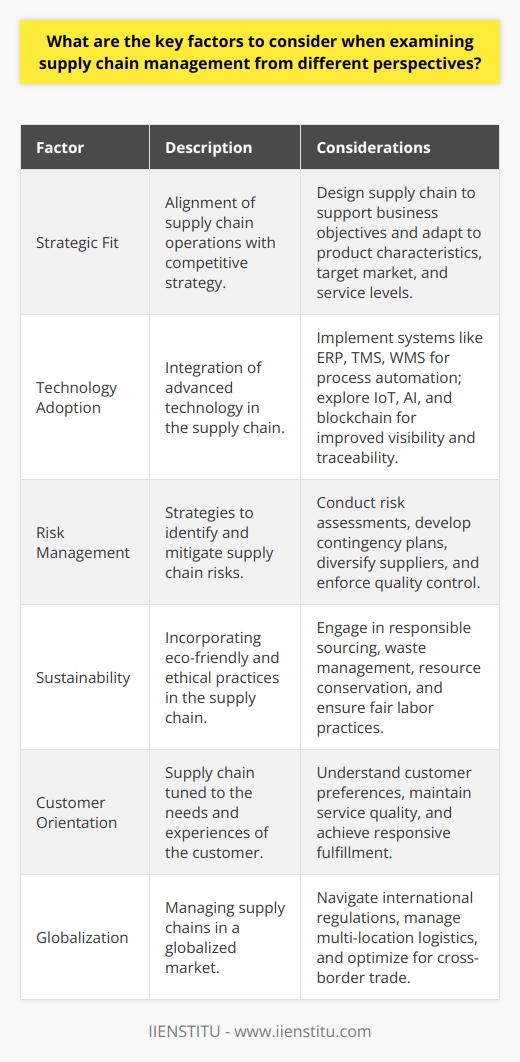
How do various supply chain perspectives influence decision-making and overall strategy?
Impact of Supply Chain Perspectives on Decision-Making
Diverse supply chain perspectives have a significant impact on decision-making processes and the development of overarching strategies within organizations. A company's approach to its supply chain ultimately shapes the way it sources materials, manufactures products, and distributes goods to customers. Consequently, varied perspectives on supply chain management can lead to different strategic choices and outcomes.
Integration and Collaboration
An integrated and collaborative supply chain perspective emphasizes building strong relationships with suppliers, service providers, and customers. This approach fosters trust, communication, and information sharing, which in turn allows for more informed decision-making. Consequently, businesses adopting this perspective often prioritize long-term partnerships and collaborative problem-solving to enhance efficiency and effectiveness in their supply chains.
Sustainability and Ethical Considerations
Companies increasingly adopt a sustainability-focused perspective in their supply chain strategies to meet the growing demand for environmentally friendly and ethically sourced products. This perspective influences decision-making by placing a greater emphasis on considering the long-term environmental and social impacts of supply chain operations. As a result, businesses may opt for more sustainable suppliers, materials, and transportation methods, even if short-term costs are higher.
Cost-Efficiency and Competition
A cost-efficiency perspective in supply chain management centers on minimizing expenses and improving profit margins. This approach may influence decision-making by pushing companies to prioritize cost-saving measures in their supply chain, such as low-cost sourcing, lean manufacturing practices, or optimizing delivery routes. While aiming to achieve a competitive advantage, this perspective can undervalue other critical aspects, such as sustainability or collaboration.
Agility and Responsiveness
Supply chain agility allows businesses to adapt quickly and effectively to unexpected changes, such as fluctuating customer demands or disruptions in supplier relationships. This perspective influences decision-making by encouraging organizations to invest in flexible supply chain structures, such as risk diversification in their supplier base, or the implementation of advanced information systems for real-time data sharing. These choices help companies become more resilient under uncertainty, enhancing their overall supply chain capabilities.
Conclusion
In summary, diverse perspectives on supply chain management, including integration and collaboration, sustainability and ethical considerations, cost-efficiency, and agility, significantly influence an organization's decision-making processes and overall strategic direction. Acknowledging and embracing these different perspectives allows businesses to develop well-rounded supply chain strategies that address a broad array of concerns and objectives, ultimately enhancing their competitive position in the market.
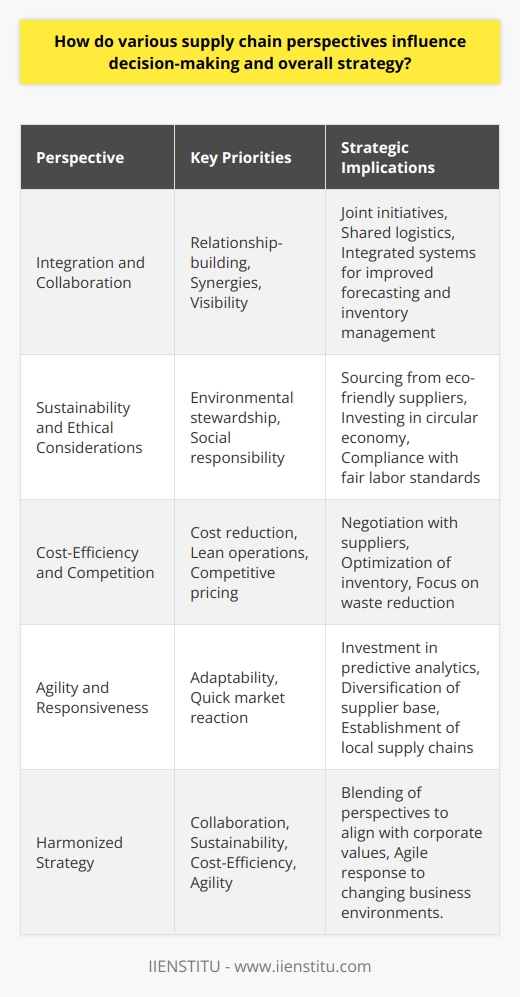
What is the significance of adopting a multifaceted approach when studying supply chain management?
Understanding Complex Relationships
The adoption of a multifaceted approach when studying supply chain management is essential due to the complex nature of the relationships among suppliers, producers, and customers. Supply chains are composed of a set of diverse interactions that go beyond simple transactional dependencies, involving various organizational and functional connections.
Considering Multiple Factors
A comprehensive understanding of supply chain dynamics requires considering multiple factors such as transportation, warehousing, procurement, and production processes. Integrating these aspects holistically contributes to a more effective optimization of the chain, enhancing overall efficiency and competitiveness. Moreover, recognizing the interdependence of these factors enables better decision-making, as managers can anticipate potential difficulties and seek to overcome them proactively.
Navigating Global Challenges
Today's global business environment poses several challenges for supply chain management, including volatile market conditions, increasing competition, and evolving customer demands. A multifaceted approach equips practitioners to better navigate these complexities, promoting the development of more robust and adaptive strategies. By considering diverse perspectives and acknowledging the interconnectedness of various factors, supply chain professionals can better identify risks and opportunities and implement appropriate adjustments.
Balancing Stakeholder Interests
Furthermore, a multifaceted approach to studying supply chain management allows for a more comprehensive understanding of stakeholder interests. By recognizing the diverse needs and priorities of suppliers, manufacturers, customers, and other parties, businesses can aim to achieve more balanced and mutually beneficial outcomes. This can lead to stronger relationships and enhanced collaboration among supply chain participants, ultimately fostering long-term partnerships and shared success.
Embracing Technological Advancements
An essential element of a multifaceted approach is the acknowledgement and integration of technological advancements shaping modern supply chains. From big data analytics to internet of things (IoT) technologies, understanding the potential of these innovations contributes to more informed decision-making and continuous improvement. Incorporating technology into the analysis of supply chain management empowers practitioners to identify trends, anticipate disruptions, and increase overall efficiency.
In conclusion, adopting a multifaceted approach to studying supply chain management is vital due to the inherent complexity and interdependence of its various elements. By embracing this comprehensive perspective, practitioners can better understand and navigate global challenges, balance stakeholder interests, and leverage technological advancements to optimize efficiency and drive competitiveness in today's dynamic business landscape.
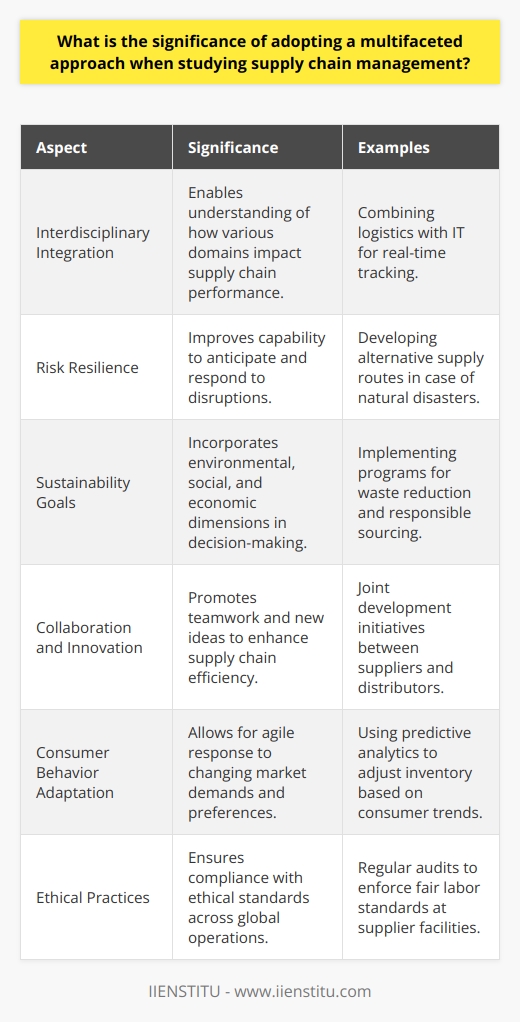
What are the perspectives of supply chain management?
Supply Chain Management: Strategic Perspective
Supply chain management (SCM) from a strategic perspective focuses on long-term decisions. This includes supply chain design, partner selection, and high-level planning. Businesses use strategic SCM to improve efficiency and gain a competitive advantage.
Operational Perspective of SCM
The operational perspective of SCM involves day-to-day activities. These include production scheduling, transportation, and quality control. Effective operational SCM ensures smooth flow of goods and services.
Financial Perspective of Supply Chain
From a financial perspective, SCM aims at cost reduction and profit maximization. This involves inventory management, cost reductions, and cash flow management. Sound financial management of the supply chain contributes to economic growth.
The Green Supply Chain Perspective
The green supply chain perspective focuses on environmental considerations. It involves waste management, reducing emissions, and sustainable sourcing. Implementing green SCM helps businesses become socially accountable.
The Agile Supply Chain Perspective
The agile perspective focuses on flexibility and responsiveness. It involves rapid adjustment to changes in demand or supply. Agile SCM helps businesses to respond quickly to market volatility.
Global Perspective in Supply Chain
Lastly, the global perspective of SCM entails international logistics. It considers tariffs, global sourcing, and international trade regulations. Global supply chains need careful management to navigate challenges of cross-border trade.
In conclusion, SCM perspectives influence how businesses operate. They provide strategic direction for establishing and maintaining efficient, cost-effective supply chains. Therefore, a comprehensive understanding of these perspectives is essential for effective SCM.
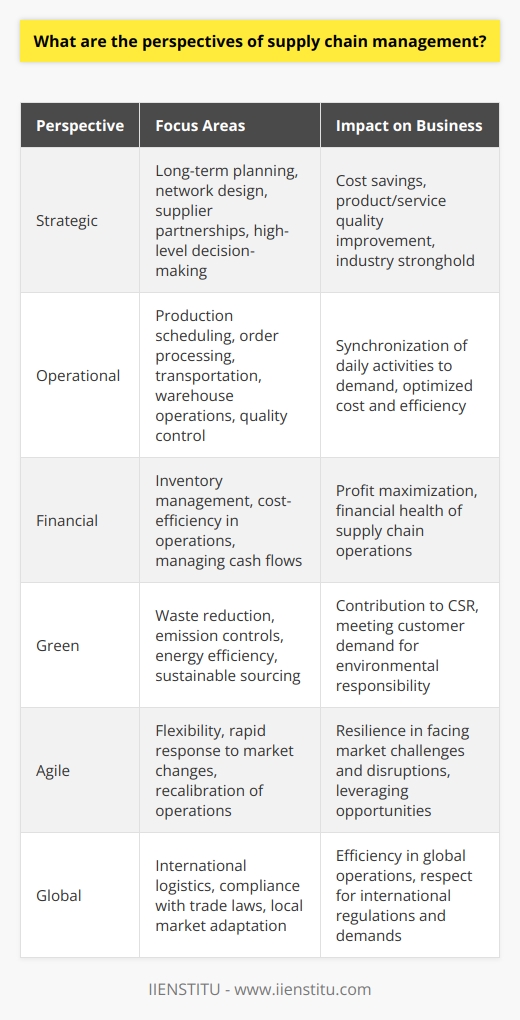
What is a supply chain explain and provide some real life examples?
Supply Chain Definition
A supply chain refers to a system of organizations, people, activities, information, and resources involved in moving a product or service from supplier to customer. It encompasses all the steps required to get a product or service from its original state to the end user.
Stages in a Supply Chain
Various stages comprise a supply chain. It starts with acquiring raw materials. This stage implies extracting or harvesting resources needed for the production. The second stage includes production or manufacturing, where raw materials transform into the final product. Next comes distribution, which entails moving the finished product from the manufacturer to the retail outlets. The last step is consumption, which refers to getting the product into the hands of the end-user or consumer.
Real Life Examples
Numerous everyday examples illustrate supply chains. For instance, consider the creation of a book. The wood comes from a forest, a form of raw material acquisition. Next, a factory processes the wood into paper, depicting the manufacturing stage. A publishing company may then print and bind the text onto the paper, a part of the distribution phase. Ultimately, a bookstore sells the finished book to a consumer, demonstrating the consumption stage.
Another example exhibits in the food industry. A farmer may grow tomatoes as the raw material. The farmer then sells the tomatoes to a grocery store (distribution stage), where a consumer purchases them (consumption stage).
Thus, the supply chain represents an integral part of the business landscape, connecting various stages of product life and ensuring the smooth flow of goods and services from origin to end-user.
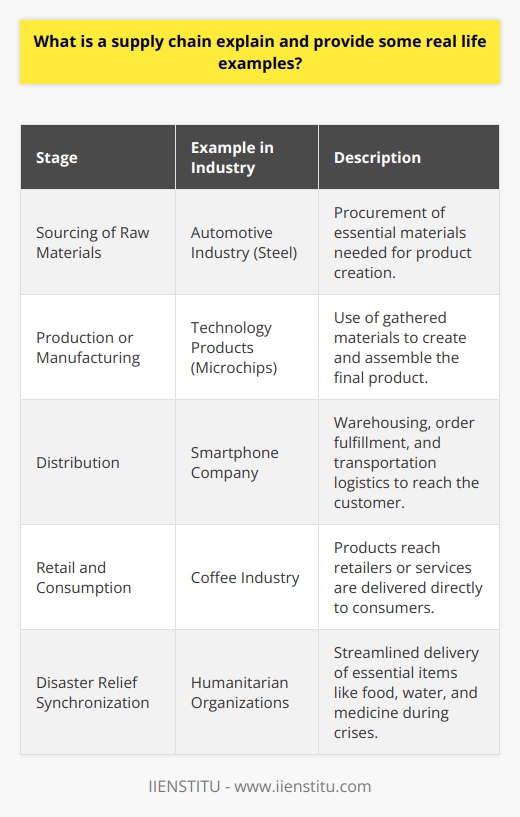
What is supply chain management with example?
Defining Supply Chain Management
Supply Chain Management (SCM) refers to the systematic coordination and integration of all activities involved in the production and delivery of goods or services. It encompasses everything from raw materials procurement to final product distribution, striving for operational efficiency and customer satisfaction.
Illustrative Example of SCM
Consider a coffee shop, for instance. The coffee shop's supply chain management includes coordinating with farmers for the supply of coffee beans, planning logistics for global transportation, identifying quality controls during roasting and packaging, and finally distributing it to the retail stores.
Role of SCM
Each of these steps in the supply chain must run smoothly and efficiently. This is to ensure the highest quality of products, timely delivery, and optimal profit margins. Effective SCM can build strong supplier relationships, improve inventory management, reduce operational costs, and increase customer satisfaction.
Importance of SCM
Effective supply chain management can significantly contribute to a business's success. The coffee shop’s profitability relies on the efficient management of its supply chain. An uncontrolled rise in raw material price, transportation delays, or poor quality can severely impact the bottom line and tarnish the brand image.
In conclusion, supply chain management is an integral part of business operations that ensure end-to-end efficiency and customer satisfaction. By managing interactions with suppliers, controlling production processes, and coordinating distribution activities, businesses can deliver high-quality products and services to consumers in a timely and cost-effective manner.
